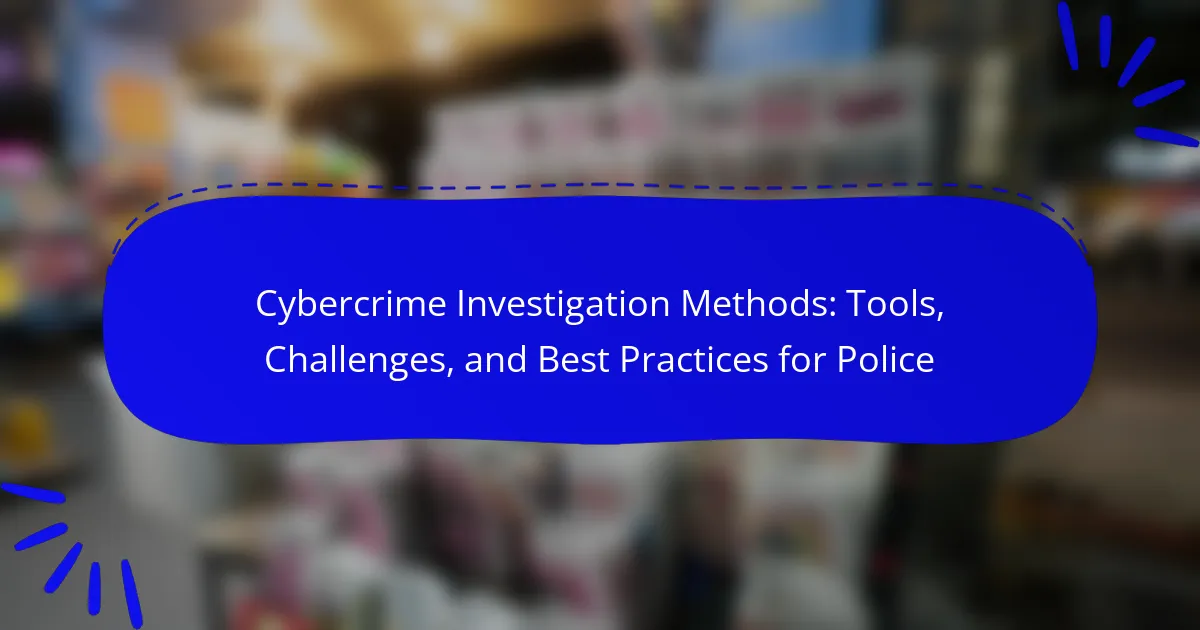
What are Cybercrime Investigation Methods?
Cybercrime investigation methods include various techniques used to detect, analyze, and prevent cybercrimes. These methods encompass digital forensics, which involves recovering and analyzing data from electronic devices. Law enforcement agencies often utilize network analysis to track and monitor suspicious online activities. Malware analysis helps identify malicious software used in cyberattacks. Additionally, open-source intelligence (OSINT) gathers publicly available information to support investigations. Cyber threat intelligence involves collecting and analyzing data on potential threats. Collaboration with international agencies enhances the effectiveness of investigations. These methods are essential for addressing the increasing complexity of cybercrime.
How do Cybercrime Investigation Methods evolve with technology?
Cybercrime investigation methods evolve as technology advances. Law enforcement agencies adopt new tools to combat increasingly sophisticated cyber threats. For instance, the rise of artificial intelligence enhances data analysis capabilities. Investigators now use machine learning algorithms to identify patterns in large datasets. Additionally, blockchain technology aids in tracking cryptocurrency transactions. This evolution is evident in the development of digital forensics tools. These tools allow for the recovery and analysis of digital evidence from various devices. Furthermore, collaboration with tech companies improves information sharing and response times. As cybercriminals innovate, so too must the methods used to investigate them.
What role does technology play in modern cybercrime investigations?
Technology is essential in modern cybercrime investigations. It enables law enforcement to gather, analyze, and preserve digital evidence efficiently. Tools such as forensic software can recover deleted files and analyze data from various devices. Advanced algorithms help in identifying patterns and connections in large data sets. Cybersecurity measures protect sensitive information during investigations. Communication technologies facilitate collaboration between agencies across jurisdictions. Moreover, machine learning enhances threat detection and incident response. Research indicates that 95% of law enforcement agencies utilize technology in their cybercrime units. This reliance on technology significantly increases the effectiveness of investigations.
How have traditional investigation methods adapted to cybercrime?
Traditional investigation methods have adapted to cybercrime by integrating digital forensics and cyber intelligence. Investigators now utilize specialized software to analyze digital evidence. They employ techniques such as network analysis and data recovery to trace cybercriminal activities. Training programs have been developed for law enforcement to enhance their cyber skills. Collaboration with tech companies has become essential for accessing advanced tools. Cybercrime units have been established within police departments to focus on these cases. Additionally, traditional interviewing techniques are now combined with digital evidence analysis. This evolution reflects the increasing complexity of cybercriminal behavior.
Why are Cybercrime Investigation Methods essential for law enforcement?
Cybercrime investigation methods are essential for law enforcement because they enable the detection, prevention, and prosecution of cybercrimes. These methods provide law enforcement with the necessary tools to trace digital footprints left by criminals. They also help in gathering evidence that is admissible in court. The increasing prevalence of cybercrimes, which accounted for an estimated $1 trillion in damages globally in 2020, highlights the urgency for effective investigation techniques. Furthermore, the complexity of cybercriminal activities necessitates specialized knowledge and skills that these methods impart to law enforcement agencies. Effective cybercrime investigations can lead to the dismantling of organized cybercrime groups, enhancing public safety. Overall, these methods are crucial in maintaining the integrity of digital infrastructures and protecting citizens from online threats.
What impact does cybercrime have on society?
Cybercrime significantly impacts society by undermining trust in digital systems. It leads to financial losses for individuals and businesses, with global damages estimated at over $1 trillion annually. Cybercrime also causes emotional distress for victims, affecting their mental health and sense of security. Furthermore, it disrupts essential services, such as healthcare and public safety. The rise of cybercrime has prompted increased spending on cybersecurity measures, diverting resources from other societal needs. Additionally, it creates a climate of fear and uncertainty, hindering innovation and growth in the digital economy.
How do these methods help in preventing future cybercrimes?
These methods help in preventing future cybercrimes by enhancing law enforcement’s ability to detect and respond to threats. They utilize advanced technology to analyze patterns of criminal behavior. This analysis allows for the identification of vulnerabilities in systems. By addressing these vulnerabilities proactively, organizations can strengthen their defenses. Training and education provided through these methods raise awareness among users. Increased awareness leads to better security practices. Collaboration between agencies fosters information sharing, which improves overall response strategies. Studies show that proactive measures significantly reduce the incidence of cybercrime.
What are the main categories of Cybercrime Investigation Tools?
The main categories of Cybercrime Investigation Tools include digital forensics tools, network analysis tools, malware analysis tools, and data recovery tools. Digital forensics tools assist in recovering and analyzing data from devices. Network analysis tools monitor and analyze network traffic for suspicious activity. Malware analysis tools help in understanding and mitigating malicious software. Data recovery tools retrieve lost or deleted information that may be relevant to investigations. Each category serves a specific purpose in the overall process of cybercrime investigation, aiding law enforcement in effectively addressing cyber threats.
What types of software are commonly used in cybercrime investigations?
Commonly used software in cybercrime investigations includes forensic analysis tools, network monitoring software, and malware analysis programs. Forensic analysis tools, like EnCase and FTK, help recover and analyze data from devices. Network monitoring software, such as Wireshark, captures and analyzes network traffic in real-time. Malware analysis programs, like IDA Pro and Cuckoo Sandbox, examine suspicious files for malicious behavior. These tools are essential for identifying, tracking, and prosecuting cybercriminals effectively.
How do hardware tools support cybercrime investigations?
Hardware tools support cybercrime investigations by providing essential capabilities for data recovery and analysis. These tools can retrieve deleted files from hard drives and mobile devices. They enable forensic examination of digital evidence, ensuring integrity and authenticity. Hardware write-blockers prevent unintentional modification of data during analysis. Specialized hardware can analyze network traffic and detect anomalies indicative of cybercrime. For example, devices like network analyzers can capture and inspect data packets in real-time. Additionally, hardware tools facilitate the secure storage of evidence, preserving it for legal proceedings. The use of such tools enhances the efficiency and accuracy of cybercrime investigations, making them indispensable for law enforcement agencies.

What challenges do police face in Cybercrime Investigations?
Police face several challenges in cybercrime investigations. One major challenge is the rapid evolution of technology. Cybercriminals often use advanced tools that outpace law enforcement capabilities. Jurisdictional issues complicate investigations across borders. Different countries have varying laws regarding cybercrime. Evidence collection is also difficult due to encryption and anonymity online. Many cybercriminals operate under pseudonyms, making identification challenging. Additionally, the lack of resources and training can hinder effective investigations. Many police departments struggle to keep up with the necessary skills and tools. Finally, public awareness and cooperation can be limited, affecting reporting and collaboration. These factors collectively create a complex environment for police in cybercrime investigations.
How do jurisdictional issues complicate Cybercrime Investigations?
Jurisdictional issues complicate cybercrime investigations by creating legal barriers across different regions. Cybercriminals often operate from locations that differ from their victims. This can lead to conflicts in law enforcement authority and legal processes. Different countries have varying laws regarding data privacy, evidence collection, and prosecution. These discrepancies can delay investigations and hinder cooperation between agencies. For example, the Mutual Legal Assistance Treaties (MLATs) can be slow and cumbersome. Additionally, some jurisdictions may not recognize certain cybercrimes as offenses. This lack of uniformity complicates the ability to track and apprehend suspects effectively.
What are the legal barriers faced by law enforcement in cybercrime cases?
Law enforcement faces several legal barriers in cybercrime cases. Jurisdictional issues complicate investigations across state and national borders. Different countries have varying laws regarding data privacy and cybercrime. This can hinder the ability to collect evidence. Additionally, obtaining warrants for digital evidence often requires more time than traditional searches. Legal frameworks may not keep pace with rapid technological advancements. There are also challenges in securing cooperation from private companies that hold data. These barriers can delay investigations and prosecutions, impacting overall effectiveness.
How does international cooperation affect cybercrime investigations?
International cooperation significantly enhances cybercrime investigations. It allows law enforcement agencies from different countries to share critical information. This collaboration leads to faster identification of cybercriminals. Joint operations can dismantle criminal networks that span multiple jurisdictions. For instance, the Europol Cybercrime Centre facilitates cross-border investigations. This center has successfully coordinated operations that resulted in numerous arrests. Furthermore, international treaties like the Budapest Convention provide a legal framework for cooperation. These treaties enable countries to request assistance in investigations seamlessly. Overall, international cooperation is vital for effective cybercrime enforcement.
What are the technical challenges in Cybercrime Investigations?
Technical challenges in cybercrime investigations include data encryption, anonymity of perpetrators, and the rapid evolution of technology. Data encryption often prevents investigators from accessing crucial evidence. Anonymity is achieved through various methods, such as VPNs and the dark web, complicating the identification of suspects. The rapid evolution of technology leads to new forms of cybercrime, requiring continuous training and adaptation by law enforcement. Additionally, jurisdictional issues arise when crimes span multiple regions or countries. The sheer volume of data generated in cybercrimes can overwhelm traditional investigative methods. These challenges necessitate advanced tools and techniques for effective investigation.
How does encryption impact the ability to investigate cybercrimes?
Encryption significantly hinders the ability to investigate cybercrimes. It protects data by transforming it into a format that is unreadable without the proper key. Law enforcement agencies often struggle to access encrypted communications and files during investigations. For instance, in 2016, the FBI faced challenges accessing the encrypted data on an iPhone related to a terrorist attack. This case highlighted how encryption can obstruct timely investigations. Additionally, many criminals use encryption to conceal illicit activities online. This makes it difficult for investigators to gather evidence. Overall, encryption poses a major obstacle in the effective investigation of cybercrimes.
What challenges arise from the rapid evolution of cyber threats?
The rapid evolution of cyber threats presents significant challenges for law enforcement. First, the increasing sophistication of attacks makes detection and prevention difficult. Cybercriminals adapt quickly, employing advanced techniques that outpace traditional security measures. Second, the global nature of cybercrime complicates jurisdiction and cooperation among agencies. Different countries have varying laws and resources, creating hurdles in investigations. Third, the sheer volume of data generated by digital activities overwhelms existing analytical capabilities. This makes it challenging for investigators to identify relevant information quickly. Lastly, the continuous emergence of new technologies introduces additional vulnerabilities. Each innovation can be exploited, requiring constant updates to strategies and tools. These challenges necessitate ongoing training and collaboration among law enforcement agencies to effectively combat cyber threats.
What human factors contribute to challenges in Cybercrime Investigations?
Human factors significantly contribute to challenges in cybercrime investigations. One major factor is the lack of skilled personnel. Many law enforcement agencies struggle to find officers with expertise in technology and cybersecurity. Another issue is the rapid evolution of technology. Criminals often use advanced tools that outpace investigators’ capabilities. Additionally, communication barriers exist between departments. Different agencies may have varying protocols and tools, complicating collaboration. Furthermore, the psychological impact on investigators can hinder performance. Stress and burnout from dealing with complex cases can lead to errors. Lastly, public perception and trust issues can affect investigations. Victims may hesitate to report crimes due to fear of not being taken seriously. These human factors collectively create significant obstacles in effectively tackling cybercrime.
How does the lack of training affect law enforcement’s ability to combat cybercrime?
The lack of training significantly impairs law enforcement’s ability to combat cybercrime. Insufficient training leads to a lack of understanding of cyber threats. Officers may struggle to identify and analyze digital evidence effectively. This gap hinders their capacity to investigate cyber incidents thoroughly. According to a 2020 report by the International Association of Chiefs of Police, 70% of law enforcement agencies reported inadequate training in cybercrime. Consequently, this results in longer response times and increased vulnerability to cybercriminals. Additionally, untrained personnel may fail to utilize available technology efficiently. Overall, the lack of training creates a critical barrier in the fight against cybercrime.
What role does public awareness play in supporting investigations?
Public awareness significantly aids in supporting investigations. Increased public awareness fosters community engagement. Engaged communities are more likely to report suspicious activities. This reporting provides law enforcement with critical leads. For instance, in cybercrime cases, tips from the public can lead to the identification of suspects. Research indicates that public involvement can enhance the effectiveness of investigations. A study by the International Association of Chiefs of Police found that community cooperation improves crime-solving rates. Thus, public awareness plays a crucial role in enhancing the success of investigations.

What are the best practices for police in Cybercrime Investigations?
Best practices for police in cybercrime investigations include establishing specialized cybercrime units. These units should be trained in digital forensics and cyber laws. Collaboration with other law enforcement agencies and private sector experts is essential. Police should utilize advanced technology for data collection and analysis. Maintaining a clear chain of custody for digital evidence is crucial. Regular training and updates on emerging cyber threats are necessary. Developing public awareness programs can aid in reporting cybercrime. Engaging with international law enforcement networks enhances global cooperation.
How can law enforcement agencies improve their Cybercrime Investigation methods?
Law enforcement agencies can improve their cybercrime investigation methods by adopting advanced technologies. These technologies include artificial intelligence and machine learning for data analysis. Implementing real-time monitoring systems enhances threat detection capabilities. Agencies should also invest in specialized training for personnel to handle cyber incidents effectively. Collaboration with private sector cybersecurity firms can provide valuable insights and resources. Establishing clear protocols for information sharing among agencies can streamline investigations. Regularly updating tools and software ensures they remain effective against evolving threats. Engaging in continuous research and development fosters innovation in investigative techniques.
What training programs are effective for cybercrime investigators?
Effective training programs for cybercrime investigators include the Certified Cybercrime Investigator (CCI) program and the SANS Institute Cybersecurity Training. The CCI program provides comprehensive training on digital forensics and cyber law. It equips investigators with skills to analyze cyber incidents and gather evidence legally. The SANS Institute offers various courses focusing on network security and incident response. These courses are recognized in the industry for their rigor and practical application. Additionally, the International Association of Computer Investigative Specialists (IACIS) provides specialized training in digital forensics. This training emphasizes hands-on experience with forensic tools and methodologies. These programs are validated by industry professionals and have been shown to improve investigative outcomes.
How can agencies foster collaboration with tech companies?
Agencies can foster collaboration with tech companies by establishing clear communication channels. Regular meetings can help align goals and expectations. Sharing information on cyber threats enhances mutual understanding. Joint training programs can improve skills and knowledge transfer. Agencies should also create partnership agreements outlining responsibilities. Providing incentives for tech companies encourages participation. Engaging in joint research projects can drive innovation. These strategies have proven effective in enhancing cooperation between law enforcement and technology sectors.
What strategies can be implemented to enhance Cybercrime Investigation outcomes?
Implementing advanced forensic tools enhances cybercrime investigation outcomes. These tools enable investigators to analyze digital evidence more effectively. Training law enforcement personnel in cybercrime tactics is crucial. This training ensures that officers are equipped with the latest knowledge. Collaboration with cybersecurity experts improves access to specialized skills. Establishing partnerships with tech companies provides additional resources. Utilizing data analytics can identify patterns in cybercrime activity. Research shows that effective communication among agencies leads to faster resolutions. These strategies collectively enhance the overall efficacy of cybercrime investigations.
How can data analytics improve investigation efficiency?
Data analytics can significantly improve investigation efficiency by streamlining data processing and identifying patterns. It enables investigators to analyze vast amounts of data quickly. By utilizing algorithms, anomalies can be detected that may indicate criminal activity. This reduces the time spent on manual data review. Furthermore, predictive analytics can forecast potential criminal behavior based on historical data. Studies show that agencies using data analytics report faster case resolutions. For example, the Chicago Police Department’s use of predictive analytics resulted in a 30% reduction in crime rates. This demonstrates the tangible benefits of integrating data analytics into investigative practices.
What role does community engagement play in cybercrime prevention?
Community engagement plays a crucial role in cybercrime prevention. It fosters collaboration between law enforcement and the public. Engaged communities are more likely to report suspicious online activities. This reporting can lead to quicker investigations and interventions. Additionally, community awareness programs educate individuals about cyber threats. According to the FBI, community initiatives can reduce cybercrime rates by up to 30%. These programs empower citizens to protect themselves and others. Engaged communities can also develop trust in law enforcement. This trust encourages more proactive participation in prevention efforts.
What practical tips can law enforcement follow for effective Cybercrime Investigations?
Law enforcement can enhance cybercrime investigations by implementing several practical tips. First, they should establish a dedicated cybercrime unit. This unit should consist of trained professionals with expertise in digital forensics and cybersecurity. Second, law enforcement agencies must collaborate with other organizations. Partnerships with private sector companies and international agencies can provide valuable resources and intelligence. Third, maintaining up-to-date technology is crucial. Utilizing the latest tools for data analysis and evidence collection can improve investigation efficiency.
Additionally, law enforcement should prioritize continuous training. Regular workshops and courses can help officers stay informed about emerging cyber threats. Fourth, developing a clear protocol for handling digital evidence is essential. Proper procedures ensure that evidence is collected and preserved without contamination. Lastly, community outreach is important. Educating the public about cybersecurity can lead to more reports of suspicious activities, aiding investigations. These strategies collectively enhance the effectiveness of cybercrime investigations.
Cybercrime Investigation Methods encompass a range of techniques and tools used by law enforcement to detect, analyze, and prevent cybercrimes. This article explores various investigation methods, including digital forensics, network analysis, and malware analysis, while addressing the evolving role of technology in these processes. It highlights challenges faced by police, such as jurisdictional issues and the impact of encryption, and emphasizes the importance of community engagement and collaboration with tech companies. Best practices for improving cybercrime investigations are also discussed, providing insights into effective strategies for law enforcement agencies.
